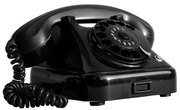The communication breakthrough of the transatlantic cable was the result of the vision and talents of two American men. Samuel F.B. Morse invented the electric telegraph, which sends messages over long distances by cable. Cyrus West Field envisioned connecting a wire across the Atlantic -- and made it happen.
Morse: The Electric Telegraph
Samuel F.B. Morse, an artist and inventor, created the first electric telegraph in 1832. The device enabled people to communicate quickly by sending signals over wire. He also invented the signals used on the telegraph, known around the world as the Morse Code. By the 1850s, thousands of miles of electric telegraph lines facilitated fast communication across the United States and Europe.
Field: Across The Ocean
Cyrus West Field, a businessman, first proposed a transatlantic cable in 1854 to shorten communication time over the ocean from several weeks to mere seconds. After four unsuccessful attempts, he and a team of British and American ships successfully connected the cable on August 5, 1858. It stretched nearly 2,000 miles across the expanse of the Atlantic and lay as deep as two miles beneath the surface.
Related Articles
References
Writer Bio
Gina Poirier has a professional background in nonprofit administration and management, primarily with youth development organizations. She holds a Bachelor of Arts in international studies from the University of Washington and a Master of Public Administration from the University of Alaska Anchorage.











